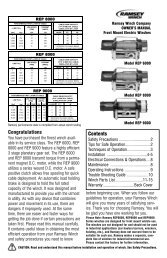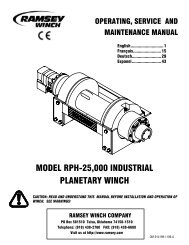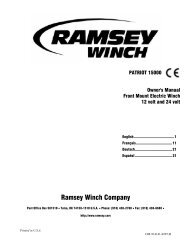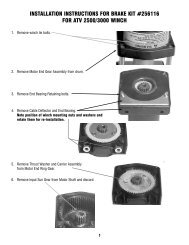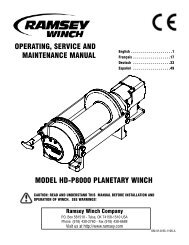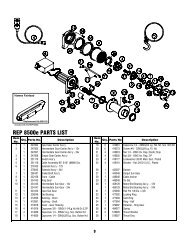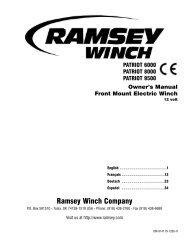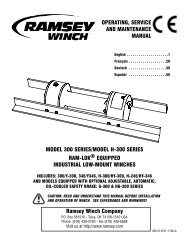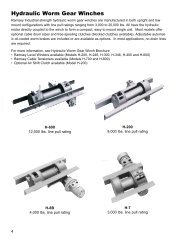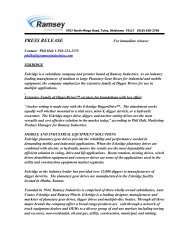rph15000 ce.qxp - Ramsey Winch
rph15000 ce.qxp - Ramsey Winch
rph15000 ce.qxp - Ramsey Winch
You also want an ePaper? Increase the reach of your titles
YUMPU automatically turns print PDFs into web optimized ePapers that Google loves.
MAINTENANCE<br />
1. Inspect the cable for damage and lubricate frequently. If the cable becomes frayed with broken strands, repla<strong>ce</strong> immediately.<br />
2. Check that the clutch is fully engaging. See OPERATION instructions, above, for the appropriate clutch shifter. FOR MANUAL CLUTCH<br />
ONLY: Monthly, disengage clutch, put several drops of oil on the clutch handle shaft and work clutch handle IN and OUT several times<br />
to lubricate inside the shifter assembly.<br />
3. Check to see that the drum cable does not overrun (“birdnest”) when freespooling. Refer to page 4 if it does.<br />
4. Repla<strong>ce</strong> drum bushings and seals if seals begin to seep grease. Refer to the Overhaul Instructions, pages 8-10. Add additional lubricant,<br />
Mobilith SHC 007, to gears and drum bearings if required.<br />
OPERATION<br />
The best way to get acquainted with how your winch operates is to make test runs before you actually use it. Plan your test in advan<strong>ce</strong>.<br />
Remember, you hear your winch as well as see it operate. Get to recognize the sounds of a light steady pull, a heavy pull, and sounds<br />
caused by load jerking or shifting. Avoid conditions where load shifts or jerks occur, as they may indicate a dangerous situation.<br />
The uneven spooling of cable, while pulling the load, is not a problem, unless there is a cable pileup on one end of the drum. If this happens,<br />
reverse the winch to relieve the load, and move your anchor point further to the <strong>ce</strong>nter of the vehicle. After the job is done you can unspool<br />
and rewind for a neat lay of the cable.<br />
When pulling a heavy load, pla<strong>ce</strong> a blanket, jacket, and tarpaulin over the cable about five or six feet behind the hook. In the event of a broken<br />
cable, this will slow the snap back of the cable and could prevent serious injury.<br />
The winch clutch allows rapid unspooling of the cable, from the cable drum, for hooking onto the load. The clutch is operated by the clutch<br />
shifter lever or air shifter.<br />
WARNING: DO NOT DISENGAGE CLUTCH UNDER LOAD!<br />
MANUAL CLUTCH SHIFTER (Refer to dimensional drawing page 11):<br />
TO DISENGAGE CLUTCH: Run the winch in the reverse (reel out) direction until the load is off the cable. Pull handle out and rotate 90°. With<br />
handle in the “DISENGAGED” position, cable may now be free-spooled from the drum.<br />
TO ENGAGE CLUTCH: Pull handle out, rotate 90° and release handle. Run the winch in reverse until the clutch handle snaps fully into the<br />
“ENGAGED” position. DO NOT attempt to pull a load unless the handle is fully at the “ENGAGED” position. If manual shift indicator light is<br />
present, the green light is lit when clutch is fully “ENGAGED”. DO NOT attempt to pull a load unless the green light is lit.<br />
AIR CYLINDER CLUTCH SHIFTER (Refer to the dimensional drawing page 12):<br />
TO DISENGAGE CLUTCH: Run the winch in the reverse (reel out) direction until load is off the cable. Apply air pressure to the .125-27 NPT<br />
port: 80 PSI (min.)-150 PSI (max.). CAUTION: PRESSURE MUST NOT EXCEED 150 PSI.<br />
TO ENGAGE CLUTCH: Remove air pressure from the cylinder (a return spring engages the plunger). Run winch in reverse until the clutch<br />
engagement indicator light (green light) is lit. To install light to the vehicle electrical system refer to the Electrical Schematic on page 12.<br />
5



